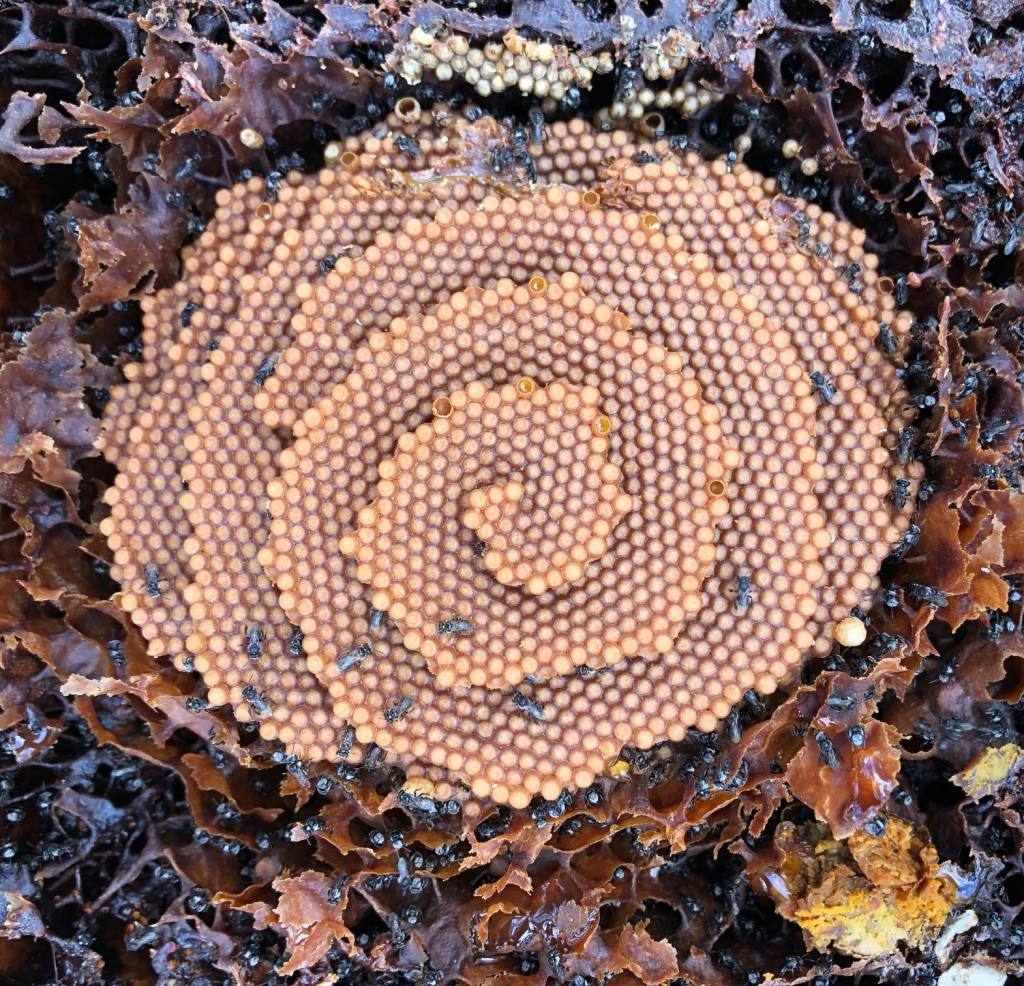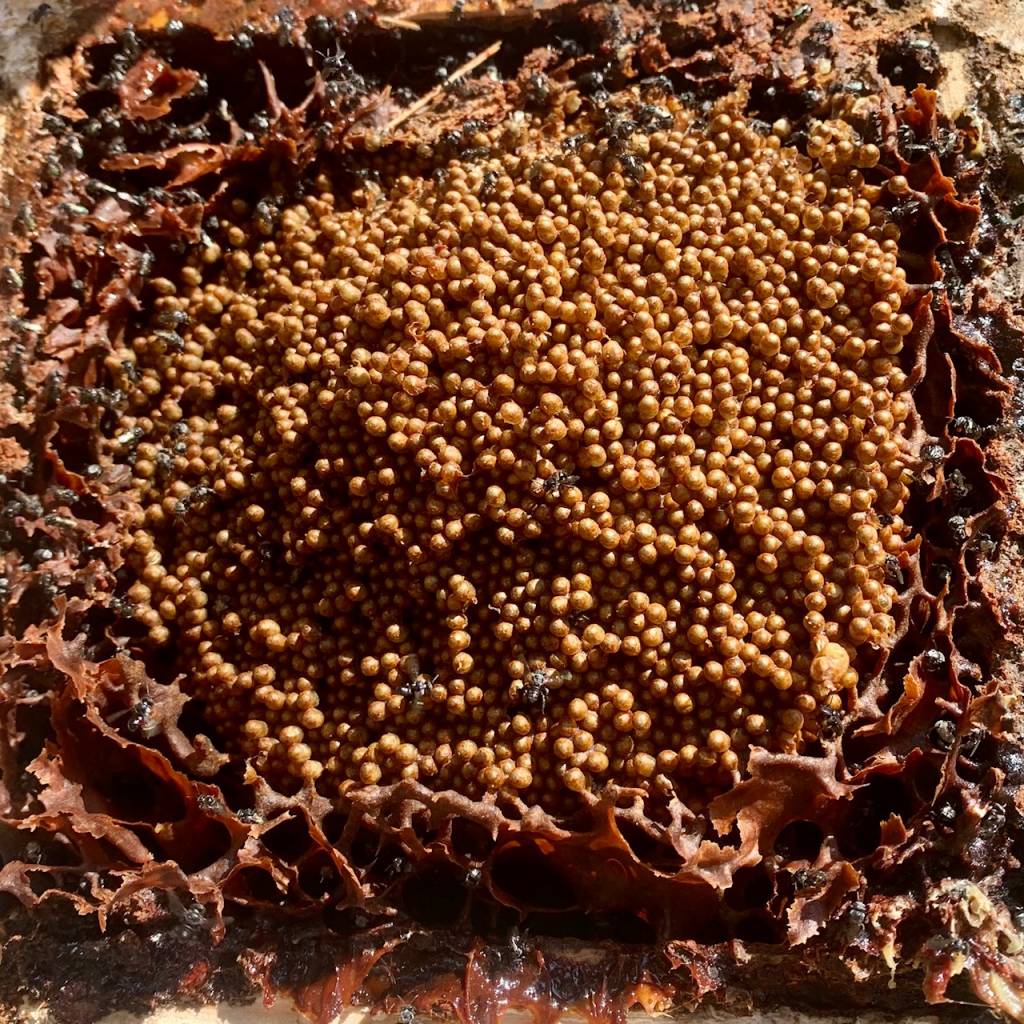What is splitting?
Approximately once every year you can split the hive into two separate colonies with a hive tool. Literally cut in two, and place each half onto another half of a new box (what we are selling here).
Instruction on how to split you hive here.
What is eduction?
Eduction is like adding an extension to your home. Essentially making a funnel to the new empty hive and the bees will eventually fill the empty box and start a new colony.
Instructions on how to setup an eduction here.
Do native bees make honey?
A hive with Tetragonula Hockingsi or Tetragonula Carbonaria are capable of producing around 1kg per year with a honey super. If you’re looking to harvest small amounts of honey at a time we would recommend one of our jar style hives.
How do the jar style hives work?
The native bees store their honey in little pots, often called sugar bags. The bees will store honey in the brood chamber but will also store any excess in the jar. The honey jar means you collect smaller amounts of honey at a time (then if you were to have a honey super) but it is less destructive and a lot easier to harvest. When you’re ready to harvest you simply unscrew the jar, wait for the bees to fly off then break the pots and strain. I include a second jar so you can place an empty one straight back on.
What are the bee hotels for?
Hotels are to encourage pollinators into your garden! The main reasons to get one are to increase pollination, help you to grow more plants and to help out the insects. It also looks quite nice as a garden decoration (if we do say so ourselves). Check out our range of bee hotels here.
I see native bees in my garden, Can I place a empty hive in the garden and will the bees move in?
Unfortunately no, Although it has been done the chance of bees creating a colony is very very slim. You will more than likely end up with a empty garden ornament. Your best option to start will be to purchase a hive with bees inside already.
Where can I buy bees from?
You would need to keep a look out for a full hive (around $500-600 for a hive with bees inside) or a log hive (around $300 literally just a limb off a branch with bees) unfortunately we have neither of these available at the moment. Generally you can find them during spring and summer for sale on places like Gumtree and Facebook marketplace. Or we have a list of resellers here.
Do social native bees sting?
No native bees do not sting but they can bite. Native bees are not aggressive and will not actively bite if you are close to the hive. Biting will usually only occur when opening the nest / hive if splitting or inspecting the brood. The bite is not very painful and can similar a ant bite.
What does OATH mean?
The term OATH (Original Australian Trigona Hive) came about from Dr Tim Heard when designing the original native bee hives. This term is an industry standard that native bee hives are built to. The outside dimensions are key with a standard OATH having outside dimensions of 280mm X 200mm and a Mini OATH having outside dimensions of 200mm X 200mm.
What does this mean and why is it important to take into account when purchasing a hive? When you go to split the as we learned earlier, the two new sections need to match the existing hive. If you have an OATH design you will be able to purchase an empty hive from anyone that builds OATH hives. If your hive is not built the OATH dimensions you are either stuck with that design or will need to create adapter plate to ensure the hive is protected from pests. Like Lego if the parts are the same they will stack perfectly.
How do you transport bee hives?
It is recommend to transport / relocate native bee hives at night time. After the sun goes down cover the entrance with fly screen mesh or travel plug so the bees can still breath and ensure any drain holes are plugged up. Then transport to the new location. If the bee hive is moved during the day all of the worker bees that are out foraging will return to the original location to a home that is no longer there, never to find their home again. If transport can only be done during the day lock the bees in the night before transport after dark again, they will be ok until the next day move.
What are the most common social native bees?
The most commonly found social native bees are Tetragonula Carbonaria and Tetragonula Hockingsi. Carbonaria can be identified by their beautiful spiral shaped brood pattern. While Hockingsi will build their brood in seemly at random. Example of Hockingsi brood pattern. Example of Carbonaria brood pattern.


Rescues and Eductions
When performing a hive rescue/relocation or eduction, it may be beneficial to use a clear sheet of plastic to temporarily reduce the internal volume of the hive. This can be achieved by cutting to fit a piece of thin plastic (purchased in packs from office supply stores etc) and fixing in place masking tape. This creates a smaller area for the bees to build up and to guard. It can in our experience, reduce the risk of pests and encourage a faster building of structures.
Holes can be added to the bottom of the hive to allow for drainage in the instance of a small amount of spilt honey etc. We add these to hives if we need, generally 2 x 8mm holes in the base.
Instructions on how to setup an eduction here.
Native Bee Hive Placement
Generally we recommend your hives be placed in an are that receives sun first thing in the morning then shade from between 10am to 2pm. Please assess your environment for the best location and feel free to contact us for advice.
More Information on Native Bee FAQs
The Native Bee FAQs information was good but I want to know more! Check out our range of books by Tim Heard and John Klumpp.
Or if we did not answer your question with our Native Bee FAQs list reach out to us at info@abeec.com.au or 07 3206 0552
